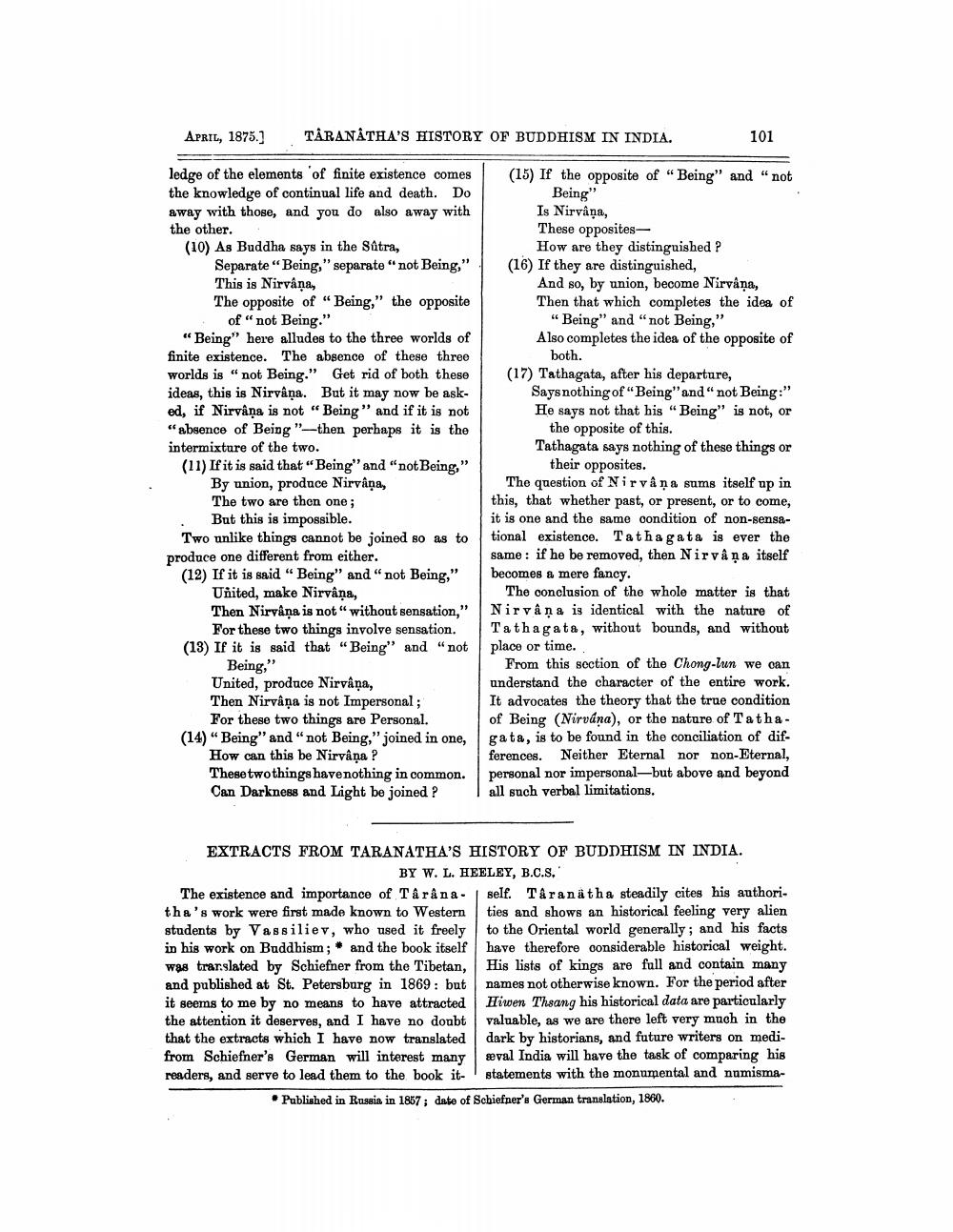________________
APRIL, 1875.)
TÅRANATHA'S HISTORY OF BUDDHISM IN INDIA.
101
ledge of the elements of finite existence comes the knowledge of continual life and death. Do away with those, and you do also away with the other. (10) As Buddha says in the Satra,
Separate" Being," separate "not Being," This is Nirvana, The opposite of "Being," the opposite
of “not Being." “Being" here alludes to the three worlds of finite existence. The absence of these three worlds is "not Being." Get rid of both these ideas, this is Nirvana. But it may now be asked, if Nirvana is not "Being" and if it is not "absence of Being "then perhaps it is the intermixture of the two. (11) If it is said that “Being" and "not Being,"
By union, produce Nirvana, The two are then one;
But this is impossible. Two unlike things cannot be joined so as to produce one different from either. (12) If it is said "Being" and "not Being,"
United, make Nirvana, Then Nirvana is not without sensation,"
For these two things involve sensation. (13) If it is said that “Being" and "not
Being," United, produce Nirvana, Then Nirvana is not Impersonal;
For these two things are Personal. (14) "Being" and "not Being," joined in one,
How can this be Nirvana ? These two things have nothing in common. Can Darkness and Light be joined ?
(15) If the opposite of "Being" and "not
Being" Is Nirvana, These opposites,
How are they distinguished ? (16) If they are distinguished,
And so, by union, become Nirvana, Then that which completes the idea of
“Being" and "not Being," Also completes the idea of the opposite of
both. (17) Tathagata, after his departure,
Says nothing of Being"and" not Being:” He says not that his "Being" is not, or
the opposite of this. Tathagata says nothing of these things or
their opposites. The question of Nirvana sums itself up in this, that whether past, or present, or to come, it is one and the same condition of non-sensational existence. Tathagata is ever the same: if he be removed, then Nirvana itself becomes a mere fancy.
The conclusion of the whole matter is that Nirvana is identical with the nature of Tathagata, without bounds, and without place or time.
From this section of the Chong-lun we can understand the character of the entire work. It advocates the theory that the true condition of Being (Nirvana), or the nature of Tathagata, is to be found in the conciliation of differences. Neither Eternal nor non-Eternal, personal nor impersonal—but above and beyond all such verbal limitations.
EXTRACTS FROM TARANATHA'S HISTORY OF BUDDHISM IN INDIA.
BY W. L. HEELEY, B.C.S. The existence and importance of Târâna. self. T&ranitha steadily cites his authori. tha's work were first made known to Westernties and shows an historical feeling very alien students by Vassiliev, who used it freely to the Oriental world generally; and his facts in his work on Buddhism; and the book itself have therefore considerable historical weight. was trar.slated by Schiefer from the Tibetan, His lists of kings are full and contain many and published at St. Petersburg in 1869: but names not otherwise known. For the period after it seems to me by no means to have attracted Hiwen Thsang his historical data are particularly the attention it deserves, and I have no doubt valuable, as we are there left very much in the that the extracts which I have now translated dark by historians, and future writers on medifrom Schiefner's German will interest many eval India will have the task of comparing his readers, and serve to lead them to the book it statements with the monumental and numisma
• Published in Russia in 1857; date of Schiefner's German translation, 1860.




